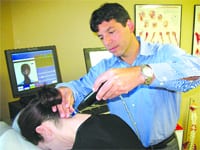Straight To The Heart At Fitness Centers, Designing Optimal Cardiovascular Workouts Is Key
Understanding the science behind cardio training and testing each individual independently are key to successful cardio programming.
To achieve optimal results, fitness enthusiasts must train at an intensity that is appropriate to their goals and current level of fitness, and within the constraints of their health. Intensity is important because too low an intensity will not produce optimal results, while too high an intensity can lead to overtraining and injury.
To maximize training benefits, exercisers need practical and accurate approaches that fit their lifestyle. Workouts must be engaging, stimulating, motivating, and results-oriented.
Cardiovascular training is a must for everyone. According to Ed Coyle at the University of Texas, Austin, “if your facility is not conducting exercises testing with credible equipment and methods, your members will not get the desired results, and you may lose your clients, if not kill them in the process.”
To better understand cardio training, you will need to know the science behind it, and some practical applications. The principles presented in this article can be used in almost any training program.
Types of Training
Moderate-intensity exercise is associated with many improvements in health-related variables. The improvement of endurance performance requires increases in qualities such as aerobic power and anaerobic threshold.
To elicit positive changes in these qualities, a minimum intensity must be reached in training. Therefore, too low an intensity will lead to positive health benefits, but is unlikely to result in a change in endurance performance. On the other hand, a chronically high intensity with lack of sufficient recovery can lead to decreases in performance; this phenomenon is known as overtraining. A practical and accurate method for monitoring training intensity is required.
Like any combustion engine, the body uses oxygen and fuel to generate energy. The cardiovascular system delivers oxygen to the skeletal muscles, which then uses this oxygen to ‘burn’ various fuels (carbohydrates and fat) to yield mechanical energy.
A unique feature of the body is its ability to change in response to the demands placed on it. By working hard, the aerobic system is overloaded. During rest, the body adapts to make itself stronger. This is accomplished by improvements in cardiovascular and muscular function. The heart becomes stronger and more efficient, and the skeletal muscles become better at extracting oxygen from the bloodstream and excreting waste back into the bloodstream. Within muscle cells, the mitochondria boost their enzyme systems to oxidize fuels.
The Science Behind It
All of these changes occur over time. For improvement, the system must be continually overloaded. As an exerciser adapts, workouts should become more difficult.
How is the right training level determined? Physiologists have discovered that the rate of oxygen ‘burned’ in the muscles is the best measure of aerobic work. To determine this, exercisers use a treadmill, elliptical machine, or cardio piece while the volume of inhaled and exhaled air is measured. Samples of exhaled air are periodically taken, and the oxygen concentration determined.
The difference between the amounts of oxygen breathed in and out during the test is what the muscles have consumed to burn fuel. Also, the ratio of these substrates tell what the muscles have burned for fuel (carbohydrates and/or fat).
Equipment that does not measure both oxygen in and carbon dioxide out is inaccurate, and the resulting exercise prescription invalid and insignificant. The rate of oxygen consumption, in liters per minute, is called VO2. The test is performed at progressively harder levels until the individual ‘maxes out.’ The maximum rate of oxygen consumption is called the VO2max or VO2peak. VO2peak may not be practical in the health club environment.
With advances in software, a sub-max test can be delivered, and the software will extrapolate the VO2peak with extraordinary accuracy. Also, on the way to a sub-max, or VO2peak, threshold, exercisers will pass through anaerobic threshold, which is another marker of cardiovascular fitness, and one that can be used to establish appropriate training zones for best and safe programming.
Anaerobic threshold (AT) represents how efficiently the muscles use oxygen to produce energy, or work. As such, AT represents the level of work the body can sustain over an extended period. When the body is called upon to perform above AT, lactic acid builds in the muscles, creating fatigue (the burning sensation felt), and the ability to continue to perform at this level is limited (a few seconds to a few minutes, depending on fitness level).
Improving the anaerobic threshold is key to developing aerobic fitness. Generally speaking, an individual’s AT may be between 52{06cf2b9696b159f874511d23dbc893eb1ac83014175ed30550cfff22781411e5} and 95{06cf2b9696b159f874511d23dbc893eb1ac83014175ed30550cfff22781411e5} of maximum heart rate. The more aerobically fit, the higher the AT.
Physiologically, in addition to burning fat in the aerobic zone, the body makes other, even more important, adaptations. Blood supply is increased through the new growth of blood vessels. This provides more nutrients to the working muscles, and helps take metabolic waste from the muscles.
The mitochondria of the cells, where the energy production takes place, multiply up to 200{06cf2b9696b159f874511d23dbc893eb1ac83014175ed30550cfff22781411e5}, providing a higher capacity for workload. The body also increases the level of hemoglobin and total blood volume. Oxygen in the blood is predominantly carried by hemoglobin, so with more hemoglobin, the working muscles get oxygen more efficiently.
With the increase in blood volume, the cardiac muscle becomes larger, increasing the amount of blood pumped per heartbeat. This means a lower heart rate at rest and more efficient recovery. The additional benefit of exercising at the appropriate intensity is increased lean mass. Muscle tissue burns, on average, 50 calories per hour per pound.
Research on VO2 has shown that there is a threshold below which no additional gains are achieved from aerobic exercise. For most people, this is a pace that allows for casual conversation during the workout, and is approximately 55{06cf2b9696b159f874511d23dbc893eb1ac83014175ed30550cfff22781411e5} of VO2peak. Above this level, exercisers are sufficiently overloading the cardiovascular and muscular systems to bring about improvement.
Related to this, group cycling is not beneficial if not performed properly. If participants exercise at too high an intensity for too long without sufficient recoveries, they become exhausted and don’t lose any weight. They need to determine their ‘real’ heart rate zones and adhere to them.
Gathering Heart Rate Data
Methods for monitoring exercise intensity include using subjective ratings of perceived exertion and monitoring blood lactate levels, heart rate, and oxygen uptake.
Interpretation of lactate data is difficult for the average recreational athlete or fitness center member. Subjective ratings of exertion have been used to monitor intensity, but several studies have shown that recreational athletes and those new to exercise judge intensity poorly with this method.
Heart rate (HR), however, can be considered both an accurate and practical measurement of exercise intensity. It should be noted, though, that HR is not a direct measurement of exercise intensity. Heart rate is often used as a tool to estimate oxygen consumed at a certain workload. There are factors, such as caffeine ingestion and dehydration, that can alter HR and affect its validity as an indicator of intensity.
Methods of monitoring HR are commonly used by endurance athletes as a measure of their training intensity, or as a pacing mechanism during competition. More recently, recreational exercisers are using HR monitors to regulate intensity with tremendous success in gaining fitness, reducing body fat, and preventing injury.
Youth fitness programs also use HR to teach pacing and skill proficiency. Heart rate has been prescribed as a method for monitoring pre-competition emotional anxiety in weightlifters. Heart rate can be used to estimate energy expenditure in exercise lasting more than three minutes. This is due to the generally linear relationship between heart rate, power output, and oxygen consumption. This relationship predicts that an increase in power output should be reflected in a proportional increase in HR.
Many methods can be used to measure HR. Commonly used methods include measurement of the pulse at the fingers or wrist, measurement of pulse pressure at the neck (carotid artery) or wrist (radial artery), measurement of opacity (how much light passes through) of the earlobes, and measurement of electrical activity of the heart at the chest.
The popularity of automated methods of recording HR has led to the inclusion of heart rate monitors on many pieces of aerobic fitness equipment. Studies conclude that the most valid and reliable system measures the electrical impulses of the heart at the chest. These systems commonly consist of a strap that is positioned just below the breast. This method of monitoring HR is extremely accurate for men, women, and children, as compared to an ECG reading. Other methods of recording HR may be unreliable; studies concluded that they might underestimate HR by up to 20 to 54 beats per minute.
As mentioned before, HR itself is not a direct indicator of exercise intensity. It is used to indicate intensity because it varies with exercise intensity. However, it can also be affected by a number of other factors, which include body position, hydration status, and drugs (beta blockers, for example).
Heart Rate and Intensity
Exercise shouldn’t be based on distance, time, or physical workload; it should be controlled by the degree of physical effort as measured by physiological signs, especially HR. Exercisers are less likely to cross the line between healthy exercise for aerobic fitness (a target heart rate of 55{06cf2b9696b159f874511d23dbc893eb1ac83014175ed30550cfff22781411e5} to 90{06cf2b9696b159f874511d23dbc893eb1ac83014175ed30550cfff22781411e5}, maximum) and risky stressful exercise with a HR monitor.
Training below minimum intensity level won’t show much improvement in aerobic capacity. Above the 90{06cf2b9696b159f874511d23dbc893eb1ac83014175ed30550cfff22781411e5} level, lactic acid will build up, resulting in decreased performance and susceptibility to injury.
Using the various formulas available for estimating HR max is fraught with error. Individuals do not have the same HR max, nor do they burn the same substrate for fuel at the same given HR intensity. There are in excess of 350 different formulas for determining HR max. The margin for error in several of the formulas is plus or minus 20. That could be catastrophic when setting up a cardio training program. Testing each individual is the key to successful cardio programming.
Keep in mind that a successful end result of an exercise program is dependent on the development of an aerobic base. The key components of an aerobic base include increasing the efficiency of the heart (stroke volume), increasing hemoglobin concentration (more oxygen transportation), and increasing muscle capillary density (better feeding system for the working muscles).
Key components of a successful weight-loss program include cardio work at the appropriate intensity, resistance training, appropriate calorie modulation, and psychological readiness.
Encouraging Cardio
The inclusion of innovative cardio programming can catalyze new growth opportunities within your facility. Not only will you have a better handle on members’ exercise intensity, but you will create a whole new vertical revenue program. This way, your members are happy, and your bottom line is growing.
Experience demonstrates a win/win scenario when appropriate, rational cardiovascular programming is introduced, supported, and optimized.
Stephen A. Black, M.Ed., P.T., A.T.C./L., C.P.T., CEO of Rocky Mountain Human Performance Center Inc. in Boulder, Colo., provides individualized programs for athletes, weekend warriors, and post-rehab clients. Black has more than 20 years experience in the health and wellness industry, and has worked with professional teams, including some in the NFL, NHL, NBA, WNBA, and ABL/NBL. He is also a presenter for the health and wellness industry. For more information, visit www.clubcoach.net.



Comments are closed.